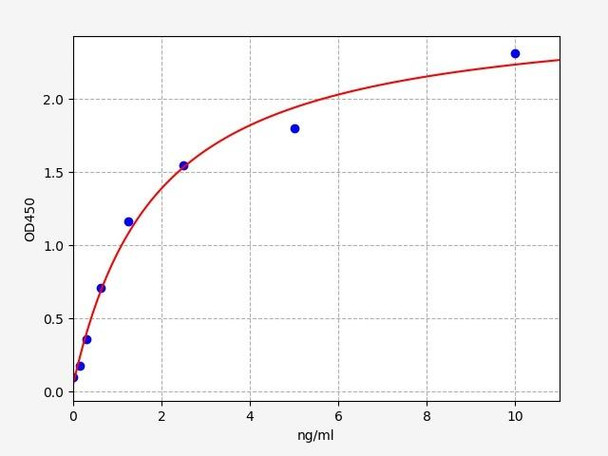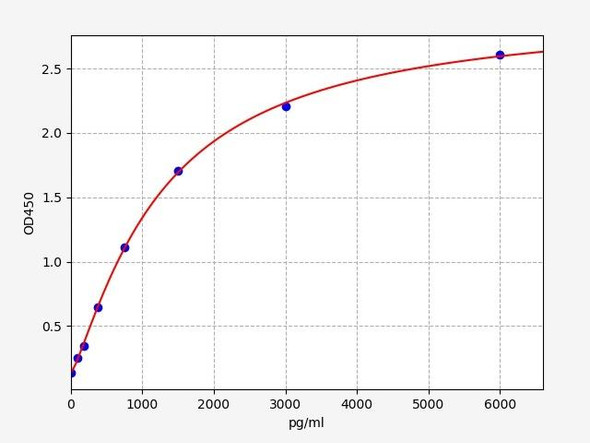Human CXCL14 ELISA Kit (HUFI01537)
- SKU:
- HUFI01537
- Product Type:
- ELISA Kit
- Size:
- 96 Assays
- Uniprot:
- O95715
- Sensitivity:
- 0.094ng/ml
- Range:
- 0.156-10ng/ml
- ELISA Type:
- Sandwich
- Synonyms:
- CXCL14, C-X-C motif chemokine 14, Small-inducible cytokine B14, Chemokine BRAK, MIP-2G, UNQ240, PRO273, PSEC0212, MIP2G, NJAC, SCYB14
- Reactivity:
- Human
- Research Area:
- Cell Biology
- Signaling Molecule:
- Chemokine
Description
Human CXCL14 ELISA Kit
The Human CXCL14 ELISA Kit is a vital tool for researchers looking to accurately measure CXCL14 levels in human samples such as serum, plasma, and cell culture supernatants. With its high sensitivity and specificity, this kit ensures precise and reliable results for a variety of research applications.CXCL14, also known as breast and kidney-expressed chemokine (BRAK), is a chemokine protein that plays a crucial role in various physiological processes, including immune responses and inflammation. Its dysregulation has been implicated in diseases such as cancer, inflammatory disorders, and metabolic syndromes, making it a valuable biomarker for studying these conditions and potential therapeutic interventions.
By using the Human CXCL14 ELISA Kit, researchers can gain valuable insights into the role of CXCL14 in disease pathogenesis and aid in the development of new treatment strategies. Trust in the accuracy and reliability of this kit to advance your research efforts in the field of immunology and disease biology.
| Product Name: | Human CXCL14 ELISA Kit |
| Product Code: | HUFI01537 |
| Size: | 96 Assays |
| Alias: | CXCL14, C-X-C motif chemokine 14, Small-inducible cytokine B14, Chemokine BRAK, MIP-2G, UNQ240, PRO273, PSEC0212, MIP2G, NJAC, SCYB14 |
| Detection method: | Sandwich ELISA, Double Antibody |
| Application: | This immunoassay kit allows for the in vitro quantitative determination of Human CXCL14 concentrations in serum plasma and other biological fluids. |
| Sensitivity: | 0.094ng/ml |
| Range: | 0.156-10ng/ml |
| Storage: | 4°C for 6 months |
| Note: | For Research Use Only |
| Recovery: | Matrices listed below were spiked with certain level of Human CXCL14 and the recovery rates were calculated by comparing the measured value to the expected amount of Human CXCL14 in samples. | ||||||||||||||||
| |||||||||||||||||
| Linearity: | The linearity of the kit was assayed by testing samples spiked with appropriate concentration of Human CXCL14 and their serial dilutions. The results were demonstrated by the percentage of calculated concentration to the expected. | ||||||||||||||||
| |||||||||||||||||
| CV(%): | Intra-Assay: CV<8% Inter-Assay: CV<10% |
| Component | Quantity | Storage |
| ELISA Microplate (Dismountable) | 8×12 strips | 4°C for 6 months |
| Lyophilized Standard | 2 | 4°C/-20°C |
| Sample/Standard Dilution Buffer | 20ml | 4°C |
| Biotin-labeled Antibody(Concentrated) | 120ul | 4°C (Protect from light) |
| Antibody Dilution Buffer | 10ml | 4°C |
| HRP-Streptavidin Conjugate(SABC) | 120ul | 4°C (Protect from light) |
| SABC Dilution Buffer | 10ml | 4°C |
| TMB Substrate | 10ml | 4°C (Protect from light) |
| Stop Solution | 10ml | 4°C |
| Wash Buffer(25X) | 30ml | 4°C |
| Plate Sealer | 5 | - |
Other materials and equipment required:
- Microplate reader with 450 nm wavelength filter
- Multichannel Pipette, Pipette, microcentrifuge tubes and disposable pipette tips
- Incubator
- Deionized or distilled water
- Absorbent paper
- Buffer resevoir
| Uniprot | O95715 |
| UniProt Protein Function: | CXCL14: Potent chemoattractant for neutrophils, and weaker for dendritic cells. Not chemotactic for T-cells, B-cells, monocytes, natural killer cells or granulocytes. Does not inhibit proliferation of myeloid progenitors in colony formation assays. Belongs to the intercrine alpha (chemokine CxC) family. |
| UniProt Protein Details: | Protein type:Motility/polarity/chemotaxis; Secreted; Chemokine; Secreted, signal peptide Chromosomal Location of Human Ortholog: 5q31 Cellular Component: Golgi apparatus; extracellular space Molecular Function:chemokine activity Biological Process: cell-cell signaling; immune response; negative regulation of myoblast differentiation; chemotaxis; signal transduction; inner ear development |
| NCBI Summary: | This antimicrobial gene belongs to the cytokine gene family which encode secreted proteins involved in immunoregulatory and inflammatory processes. The protein encoded by this gene is structurally related to the CXC (Cys-X-Cys) subfamily of cytokines. Members of this subfamily are characterized by two cysteines separated by a single amino acid. This cytokine displays chemotactic activity for monocytes but not for lymphocytes, dendritic cells, neutrophils or macrophages. It has been implicated that this cytokine is involved in the homeostasis of monocyte-derived macrophages rather than in inflammation. [provided by RefSeq, Sep 2014] |
| UniProt Code: | O95715 |
| NCBI GenInfo Identifier: | 292495003 |
| NCBI Gene ID: | 9547 |
| NCBI Accession: | O95715.2 |
| UniProt Secondary Accession: | O95715,Q6UW97, Q86U69, Q9BTR1, Q9NS21, B3KQU8, |
| UniProt Related Accession: | O95715 |
| Molecular Weight: | 13,078 Da |
| NCBI Full Name: | C-X-C motif chemokine 14 |
| NCBI Synonym Full Names: | chemokine (C-X-C motif) ligand 14 |
| NCBI Official Symbol: | CXCL14 |
| NCBI Official Synonym Symbols: | KEC; KS1; BMAC; BRAK; NJAC; MIP2G; MIP-2g; SCYB14 |
| NCBI Protein Information: | C-X-C motif chemokine 14; bolekine; MIP-2 gamma; chemokine BRAK; breast and kidney; tumor-suppressing chemokine; small-inducible cytokine B14; CXC chemokine in breast and kidney; small inducible cytokine subfamily B (Cys-X-Cys), member 14 (BRAK) |
| UniProt Protein Name: | C-X-C motif chemokine 14 |
| UniProt Synonym Protein Names: | Chemokine BRAK; MIP-2G; Small-inducible cytokine B14 |
| UniProt Gene Name: | CXCL14 |
| UniProt Entry Name: | CXL14_HUMAN |
*Note: Protocols are specific to each batch/lot. For the correct instructions please follow the protocol included in your kit.
Before adding to wells, equilibrate the SABC working solution and TMB substrate for at least 30 min at 37°C. When diluting samples and reagents, they must be mixed completely and evenly. It is recommended to plot a standard curve for each test.
| Step | Protocol |
| 1. | Set standard, test sample and control (zero) wells on the pre-coated plate respectively, and then, record their positions. It is recommended to measure each standard and sample in duplicate. Wash plate 2 times before adding standard, sample and control (zero) wells! |
| 2. | Aliquot 0.1ml standard solutions into the standard wells. |
| 3. | Add 0.1 ml of Sample / Standard dilution buffer into the control (zero) well. |
| 4. | Add 0.1 ml of properly diluted sample ( Human serum, plasma, tissue homogenates and other biological fluids.) into test sample wells. |
| 5. | Seal the plate with a cover and incubate at 37 °C for 90 min. |
| 6. | Remove the cover and discard the plate content, clap the plate on the absorbent filter papers or other absorbent material. Do NOT let the wells completely dry at any time. Wash plate X2. |
| 7. | Add 0.1 ml of Biotin- detection antibody working solution into the above wells (standard, test sample & zero wells). Add the solution at the bottom of each well without touching the side wall. |
| 8. | Seal the plate with a cover and incubate at 37°C for 60 min. |
| 9. | Remove the cover, and wash plate 3 times with Wash buffer. Let wash buffer rest in wells for 1 min between each wash. |
| 10. | Add 0.1 ml of SABC working solution into each well, cover the plate and incubate at 37°C for 30 min. |
| 11. | Remove the cover and wash plate 5 times with Wash buffer, and each time let the wash buffer stay in the wells for 1-2 min. |
| 12. | Add 90 µl of TMB substrate into each well, cover the plate and incubate at 37°C in dark within 10-20 min. (Note: This incubation time is for reference use only, the optimal time should be determined by end user.) And the shades of blue can be seen in the first 3-4 wells (with most concentrated standard solutions), the other wells show no obvious color. |
| 13. | Add 50 µl of Stop solution into each well and mix thoroughly. The color changes into yellow immediately. |
| 14. | Read the O.D. absorbance at 450 nm in a microplate reader immediately after adding the stop solution. |
When carrying out an ELISA assay it is important to prepare your samples in order to achieve the best possible results. Below we have a list of procedures for the preparation of samples for different sample types.
| Sample Type | Protocol |
| Serum | If using serum separator tubes, allow samples to clot for 30 minutes at room temperature. Centrifuge for 10 minutes at 1,000x g. Collect the serum fraction and assay promptly or aliquot and store the samples at -80°C. Avoid multiple freeze-thaw cycles. If serum separator tubes are not being used, allow samples to clot overnight at 2-8°C. Centrifuge for 10 minutes at 1,000x g. Remove serum and assay promptly or aliquot and store the samples at -80°C. Avoid multiple freeze-thaw cycles. |
| Plasma | Collect plasma using EDTA or heparin as an anticoagulant. Centrifuge samples at 4°C for 15 mins at 1000 × g within 30 mins of collection. Collect the plasma fraction and assay promptly or aliquot and store the samples at -80°C. Avoid multiple freeze-thaw cycles. Note: Over haemolysed samples are not suitable for use with this kit. |
| Urine & Cerebrospinal Fluid | Collect the urine (mid-stream) in a sterile container, centrifuge for 20 mins at 2000-3000 rpm. Remove supernatant and assay immediately. If any precipitation is detected, repeat the centrifugation step. A similar protocol can be used for cerebrospinal fluid. |
| Cell culture supernatant | Collect the cell culture media by pipette, followed by centrifugation at 4°C for 20 mins at 1500 rpm. Collect the clear supernatant and assay immediately. |
| Cell lysates | Solubilize cells in lysis buffer and allow to sit on ice for 30 minutes. Centrifuge tubes at 14,000 x g for 5 minutes to remove insoluble material. Aliquot the supernatant into a new tube and discard the remaining whole cell extract. Quantify total protein concentration using a total protein assay. Assay immediately or aliquot and store at ≤ -20 °C. |
| Tissue homogenates | The preparation of tissue homogenates will vary depending upon tissue type. Rinse tissue with 1X PBS to remove excess blood & homogenize in 20ml of 1X PBS (including protease inhibitors) and store overnight at ≤ -20°C. Two freeze-thaw cycles are required to break the cell membranes. To further disrupt the cell membranes you can sonicate the samples. Centrifuge homogenates for 5 mins at 5000xg. Remove the supernatant and assay immediately or aliquot and store at -20°C or -80°C. |
| Tissue lysates | Rinse tissue with PBS, cut into 1-2 mm pieces, and homogenize with a tissue homogenizer in PBS. Add an equal volume of RIPA buffer containing protease inhibitors and lyse tissues at room temperature for 30 minutes with gentle agitation. Centrifuge to remove debris. Quantify total protein concentration using a total protein assay. Assay immediately or aliquot and store at ≤ -20 °C. |
| Breast Milk | Collect milk samples and centrifuge at 10,000 x g for 60 min at 4°C. Aliquot the supernatant and assay. For long term use, store samples at -80°C. Minimize freeze/thaw cycles. |






